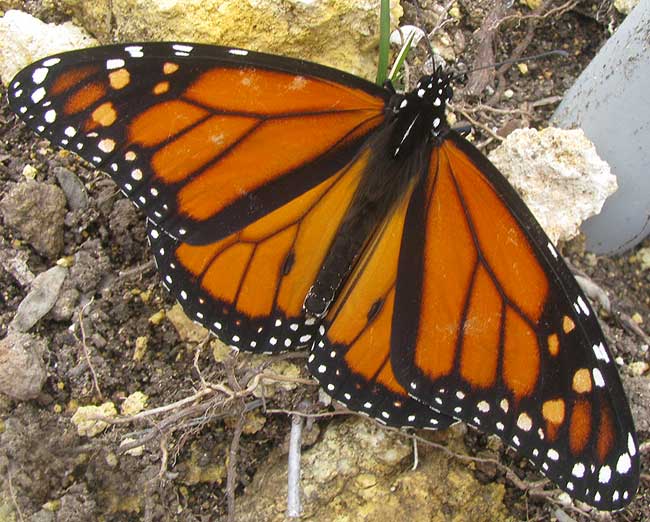
An Excerpt from Jim Conrad's
NATURALIST NEWSLETTER
December
8, 2002
Issued from the valley of the Dry Frio River in northern Uvalde County, southwestern Texas, on the southern border of the Edwards Plateau, USA

Last Saturday, the last day of November, early in the morning a male Monarch butterfly turned up in frost-killed grass just below Juniper House. That's him above. He'd slowly climb a grass stem, rest, then launch into the air, flutter a few feet, land back in the grass, rest, and then climb another stem and repeat the cycle. He did this again and again, each time making it a few feet farther south. It's very late for a Monarch to appear in Texas; usually by now they have arrived at their wintering grounds in Mexico.
This year Monarch numbers are at a historical low, and have been arriving late in Mexico in tattered, disorganized flocks. In good years as many as 450 million Monarchs overwinter in Mexico. Last year the fewest in history made the trip, with only 60 million. This year the estimates are for three million.
The same day our late Monarch passed through, Jarvis in North Carolina sent a link to a recent New York Times article entitled "The Year the Monarch Didn’t Appear," which you can find by Googling the article title. The piece suggests reasons why this is happening, and why honeybees are dying off, as are insects in general, and the birds who eat the insects, and the native plants who depend on pollinators, on and on, everything dying, and human activity appears to be the main cause, especially by habitat destruction and using new kinds of pesticides.
What is a person who sees all this to do? How is one to behave, to think, and feel?
When I'm faced with such hard questions I look for guidance into Nature. The idea is that Nature almost by definition works perfectly, so maybe in Nature's structure and manner of being there are models for my everyday life.
Looking into Nature -- which includes the whole Universe -- the most easily recognizable impulse making Nature what it is, is that as time passes there's more and more diversity, and Nature's components continually evolve to ever higher states of interdependence and sophistication. In spiritual terms, it's as if the Creator has cast dazzling sparks into empty space, and the sparks irrepressibly arrange themselves into a gorgeous bouquet.
Thinking like this does reveal many patterns that seem appropriate for humans. For example, Nature recycles resources, so humans also should recycle resources. Nature loves diversity, so humans should respect diversity, too
Something surprising is that such manner of thinking also highlights a hopeful feature about the human condition. The hope arises from the fact that humans and human mentality also are part of Nature. As such, maybe the same creative impulse accounting for Nature's unimaginable diversity the interdependency of its parts, and the irrepressible evolutionary trend toward ever higher sophistication, may manifest in us, as well.
In fact, most of us, when we are lucky enough to emerge from childhood without being seriously damaged or having our spirits crushed, when we can enjoy the luxury of thinking about things other than survival -- when we can be inspired by art and science, and reflect on the mystery of being alive -- we become awed by the world around us, and magnanimity and empathy spontaneously, magically, blossom within us. Isn't it so? You wouldn't expect this of a species whose evolutionary history has been that of competition with and domination of other species.
What can account for it, other than its being a manifestation of that creative current flowing throughout Nature toward evolving diversity, community, and ever higher levels of sophistication?
For the sake of the Monarchs, honeybees and the rest of Life on Earth, we can only hope that such is the case.